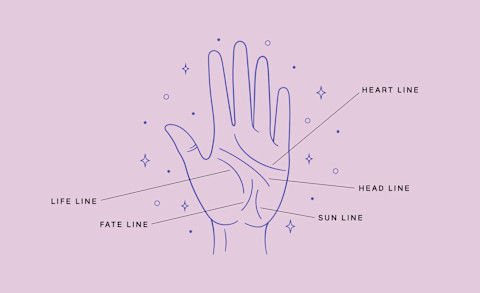
If you've already memorized your astrology chart, calculated and recalculated your numerology life path, and perfected your tarot pull, reading palms might be your next form of divination and character assessment. Here's what you need to know to do a basic palm reading on yourself or a friend.
The origins of palmistry
Palmistry is thought to have started in India, though its exact origins are unclear. We do know that it eventually spread throughout China, Tibet, Egypt, Greece (the Greek philosopher Aristotle actually spoke of palmistry in his work), and Persia over time. The mystical practice eventually faced backlash from the witch-hunters of the Middle Ages but saw a resurgence during the Renaissance and again during the Enlightenment era. During the 20th century, renowned psychiatrist Carl Jung, among others, took newfound interest in palm reading, and it has since been a favorite of fortunetellers and more casual mystics.
What a palm reading can tell you
The hand is thought to be "an entry point to the inner soul," explains Cassandra Eason, the author of A Little Bit of Palmistry. Palmistry devotees believe that its lines, mounds, and patterns can speak to everything from our talents, personality, and dreams to past lives, current circumstances, and destiny. "The lines and markings serve the same purpose as a tarot card, and each has a basic meaning," Eason says.
In Palmistry, the "active" or dominant hand reveals opportunities and challenges in your present and future, whereas you nondominant or "inactive" hand reflects your potential and longer-term plans.
How to set up for a palm reading
One thing that's nice about palm reading is you don't need to buy anything to get started. Eason does note, however, that when studying palms in detail, it can be helpful to accentuate the lines and markings with baby powder if particular areas are hard to distinguish.
If you want to keep track of your palms over time, she also recommends keeping a palmistry journal to record what you find—because, yes, it will change. You can do this by tracing your hand and drawing in what you see, always remembering to date the diagram.
RELATED STORY: How To Read Your Palm Heart Line & Decipher Its Meaning
Lines to look for

"The key to successful palm reading is to relax and trust what you feel," Eason says. Once you're set up, start by scanning your (or your friend's) dominant hand for the following lines. Then, move onto mounts, or raised sections of the hand. If you're new to palm reading, it might be difficult to decide what certain lines or mounts are telling you. Don't overthink what you find; just let yourself explore and allow your intuition to guide you.
Heart line
The heart line is the first to be studied in a reading, according to Eason, and it reveals aspects of our emotional state, relationships, as well as our potential to grow as a person. A deep line signifies emotional depth, where a faint lie reveals a very delicate energy field. A consistently broken heart line means relationships (including friendships) are often fleeting.
Head line
The head line comes next in a palm reading, and it shows how thoughts and logic manifest in our lives and how we approach the world rationally (rather than how we feel about it). A straight head line reveals a more logical approach, where curves hint at creativity. If the head line is faint, it can mean intellect isn't being used to its full potential.
Life line
The life line reveals our life force, with a strong, deep line symbolizing a zest and energy for life. Importantly, "It does not reveal how long we will live, whatever its length, but speaks of our passion for life, our pleasure in living, and physical energy," Eason notes. If your life line has breaks or faint areas, you may be lacking enthusiasm for life.
Fate or destiny line
The fate or destiny line sometimes doesn't appear until a person is in their 20s or 30s, as it deals with purpose and direction in life. Interestingly, Eason adds, "when a child knows or is directed by parents into an education and a career, the fate line will appear clearly early on in life." A straight line is associated with a relatively straightforward path, whereas a curved line can mean someone will explore different purposes throughout their life.
Mounts to look for
Mount of Venus
The largest mount on your hand, the mount of Venus is the foundation of your personality. It represents love and passion, including sexual passions, as well as sentimentality. If large and fleshy, it reveals a desire for beauty, and sometimes possessiveness. If hollow or cold, it signifies a lack of sexual desire.
Mount of Luna
The mount of Luna, or the moon, is the second largest mount on your average hand, after Venus. It deals with imagination and psychic abilities. When it's well-developed, it means that person is bursting with imagination, creativity, and spiritual interests. And if larger than Venus, it can reveal a disconnection from reality or an overactive imagination.
Mount of Apollo
The mount of Apollo corresponds with talents of any kind, from creativity to sensitivity. It also speaks to good fortune. If it's well-developed and large, it reveals success in the arts, as well as luck in games of chance or moneymaking. An underdeveloped mount of Apollo might reveal a lack of imagination.
Mount of Mercury
The mount of Mercury speaks to inventiveness, awareness of practical skills, and even psychic ability. While Apollo is more about creativity, Mercury is more about factual communication as well as devotion to family and friends. A well-formed mount of Mercury (it's naturally larger that the mount of Saturn or Apollo) signifies effective expression of ideas and healing abilities. If it's a similar size to the mount of Saturn or Apollo, that indicates the mount is underdeveloped.
Mount of Jupiter
The mount of Jupiter is "the most important for assessing strength of character," Eason says. It's all about ambition, leadership, and authority. If this mount is neither hard nor soft to the touch, it indicates a wise teacher or mentor, and someone who is ambitious but fair-minded. If it's large but hard, it can signify a big ego—and difficulty in relationships. And if it's hollow, it means that person might be more of a follower than a natural-born leader.
Mount of Saturn
The mount of Saturn deals with problems and how we cope with them. It's typically flat, with any prominence revealing firm boundaries and organization. Large prominence and firmness reveal someone who is stubborn and unwilling to change, while an underdeveloped mount of Saturn shows indecisiveness and an easily influenced nature.
Interpreting the results
There are many nuances that can be observed in one's hands; this introduction just skims the surface. As with anything else, the more you practice palmistry, the more confident you will become doing in-depth readings and interpreting the results. As you explore this tool, Eason says to remember that "the questioner is not subject to a fixed fate," meaning at the end of the day, our future is never set in stone. If we don't like what we see during a reading, we always have the free will to do something about it.
